
6 Behaviorism
This chapter covers the following attributes of the school of behaviorism, which rose to prominence in American psychology in the early 20th century. First, an achievement of behaviorism was to legitimize human and animal behavior as a topic of scientific inquiry in its own right. In this way, behaviorism carved out space between psychologies focused on intangible mental processes and physical brain-based processes. Second, behaviorism was constructed as a scientific system in the positivist tradition, which adds context to this chapter presents the goals and background ideas of the movement. Third, there were many versions of behaviorism because there were many researchers who developed and popularized their own brands. Fourth, perhaps because behaviorism was very large (occupying the time of many researchers), it included some controversial figures who are also credited with creating and expanding the movement. The core claims and goals of behaviorism continue to have implications for the cognitive sciences and society in general today.
6.1 The Rabbit Hole: To explain or not to explain?
One of the goals of this textbook is to examine how empirical evidence is used to test and develop explanations about how cognition works. The task of explaining how cognition works is an important goal for several reasons. Tentative theories provide guidance and clues about how to focus research inquiries, and good explanations can lead to the development of useful applications and technologies. Explanations are intrinsically interesting to people and worthwhile for understanding ourselves and our relationship to the world around us. At the same time, not all researchers agree that explanation is intrinsically important or useful.
For the moment, let’s consider a fictional future where the science of cognition has been fully developed in great detail, with rock-solid theoretical explanations about how human and animal cognition works. If the explanations of cognitive abilities were mechanistic in nature, they could help create new technologies to change cognitive abilities. For example, applied cognitive technologies could help people restore lost cognitive abilities or enhance existing cognitive abilities, or make machines capable of cognitive abilities. At the same time, tools to manipulate and control cognition could be scary, especially if they were used for nefarious purposes such as social and cognitive engineering to manipulate people at the level of whole societies.
In the above fictional future, explanatory theories are a pre-requisite for basic cognitive science to be translated into applied cognitive technology. Although explanatory theories that correctly describe how phenomena work at a mechanistic level can lead to new technology, some prominent behaviorists argued that mechanistic theories of cognition were unnecessary to achieve their applied goals of predicting and controlling human and animal behavior.
To provide additional context for these ideas, and before reviewing major figures in the behaviorism movement, the next section describes a modern example of behaviorist research tactics that have been developed and deployed to predict and control people’s behavior on the internet.
6.1.1 Youtube, machine-learning, and internet behaviorism
The basic ideas of behaviorism have not disappeared, and they are being used in modern society in extraordinary ways to control and manipulate cognition and behavior. Let’s start with a modern example to motivate a closer inspection of the history of behaviorism and its implications for understanding how cognition works.
The example is from a podcast called the Rabbit Hole, by New York Times columnist Kevin Roose that is generally about “what the internet is doing do us.” The first story in the podcast is a haunting account of how a young man’s life was influenced in major ways by watching YouTube videos over a period of several years. How could watching YouTube videos have such a major impact on someone’s life? According to the podcast, the answer lies in the behavior-changing methods being deployed on the internet by many companies, including YouTube.
YouTube presents video content that users access through a web browser. Web browsers allow people to interact with the internet in many ways, like searching for content or clicking links on a webpage. Web browsers also allow websites to embed code to harvest data about how people behave when they are on a website. For example, YouTube can store the history of videos that you watched, the order of videos that you clicked on, the amount of time spent watching each video, and other user data: your location, IP address, comment history and more. Furthermore, the behavioral data collected by websites can be combined with statistical techniques (like machine learning) to generate predictions about future user behavior based on patterns in the data they collect about past behavior.
YouTube collected massive amounts of video-watching behavior data from their users, and then used advanced machine learning algorithms to predict and ultimately control and manipulate user behavior. For example, one goal was to improve the video recommendation algorithm, which seems like a useful goal for users of YouTube. Improving the recommendation algorithm would help users find content they wanted to watch. YouTube also aimed to increase the amount of time users spent watching videos on the platform. By increasing the video consumption, users would be exposed to more advertisements, thereby contributing to YouTube’s overall profitability.
YouTube used the behavioral data they collected to generate predictions about which new videos to recommend to people in order to maximize their viewing time and keep them watching YouTube videos for as long as possible. In 2017, the Wall Street Journal reported YouTube hit a new milestone–1 billion hours of YouTube had been watched in a single day 1. Viewing time had increased ten times from 2012, thanks to the introduction of predictive algorithms credited with driving the behavioral change.
For some YouTube users, like the man in the podcast, the recommendation algorithm appears to have deeply impacted their personal belief systems and behavior. For example, this user spent hours upon hours watching YouTube videos, often consuming videos selected by the recommendation algorithm. Initially, his viewing habits included searches for quirky music videos, but over time the algorithm suggested new content that was predicted to increase his viewing time. The recommended content happened to be politically polarizing and veered towards the extreme right of the political spectrum.
The user attributes his interest in and involvement with white nationalist movements to his exposure to these YouTube videos. Interestingly enough, the YouTube algorithm may have also played a role in pulling him out of this rabbit hole. Once he became involved with far-right movements, he continued watching YouTube, and the algorithm kept suggesting videos that would further occupy his viewing time. At a certain point in his viewing history, he started showing some interest in videos from the left side of the political spectrum, and he attributes his decision to end his involvement in far-right politics to watching those videos.
Although the cognitive sciences have been around for quite some time, there is no widely agreed upon theory or explanation of cognition that can be used to systematically control and manipulate behavior. Nevertheless, YouTube’s algorithms, which predict future viewing behavior from large databases of past viewing behavior, appear highly successful in manipulating video watching times. This is a modern example of how methods for predicting and controlling behavior can be developed without a theory of how a cognitive ability works.
In the learning module for this chapter, students are invited to listen to the Rabbit hole podcast and then consider connections between YouTube’s algorithm and the behaviorist methods and goals discussed in the remainder of this chapter.
6.2 Enter Behaviorism
The previous chapters described characters in the historical play of psychology that set the stage for the entry of behaviorism. Already on stage were the “mentalists” and the “physicalists”.
The mentalists were interested in examining the so-called “mental” processes of cognition. For example, Galton assumed that the subjective experiences of mental images were real things that differed among people and could be objects of scientific inquiry. Titchener had developed introspectionism, where people could be trained to carefully, systematically, and “accurately” describe their inner mental experiences, and those experiences were regarded as worthy of scientific inquiry. Even Thorndike entertained the notion that animals experience mental simulations (e.g., about the possibility of food reward following an escape from a puzzle box) that establish associations between a stimulus situation and an eventual reward.
The “physicalists” were interested in examining and understanding the physiological basis of psychological processes. For example, Pavlov’s goal was to measure how stimulus-response learning processes were reflected in the production of glandular secretions.
Both sides criticized each other on several grounds– the mentalists lacked objective measures and definitions, and the physiologists were too reductive to be studying cognition. A few additional backdrops framed the entry of behaviorism.
One backdrop was scientific credentialism, which involves the socio-cultural process by which a field of study comes to be recognized as a “true” science. Psychologists were interested in gaining these credentials so that they would be recognized by society and other sciences as a proper scientists in their own right.
The concern of early psychologists that psychology should become a science is further related to the backdrops of positivism, and scientific utopianism. Positivist philosophy provided a framework for understanding science in relation to other fields, and many behaviorists espoused positivist viewpoints about the function and purpose of science. Scientific utopianism refers broadly to the notion that society can be improved through science and technology. Positivism and it’s relation to scientific utopianism are discussed in turn before proceeding to the main act of this chapter: behaviorism.
6.2.1 Positivism
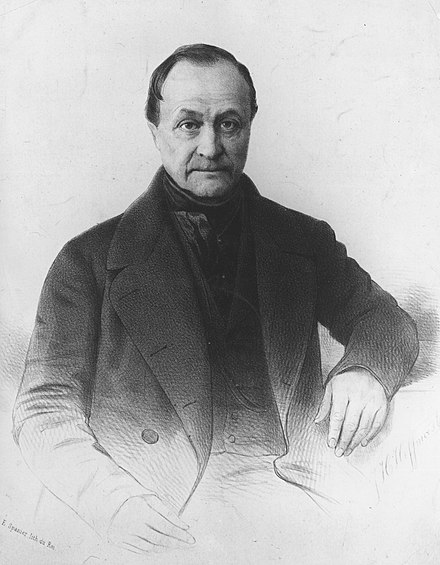
Auguste Comte (1798–1857) created positivism as a part of founding sociology. He was a French philosopher writing during a period of social upheaval 2. His work is an early example of a philosophy of science attempting to define attributes and processes of science, as well as hierarchical relations between scientific disciplines. He argued that science and society develop through three stages to explain natural phenomena: theological, metaphysical, and ultimately the positive stage.
In the theological phase, phenomena are explained by supernatural powers. For example, the mind is attributed to a soul or spiritual forces. In the metaphysical stage, phenomena are explained by ill-defined abstractions. For example, the mind could be attributed to psychic forces. In the positive stage, phenomena are finally “explained” when they can be functionally predicted and controlled through a descriptive mathematical system. For example, if the mind could be described in terms of mathematical equations that can be shown to predict and control a person’s behavior, then a practical and useful description system has been achieved, and the final positive stage has been reached.
Note that I quoted the word “explained” when referring to the positive stage. This is because positivism was not particularly interested in explanation in the mechanistic sense. The primary interest was finding a functional description system that was capable of predicting and controlling the behavior of a system of interest. For example, if the mathematical equations for describing how a mass on a spring bounces also happened to statistically account for data in some other complex system (that was clearly not a mass on a spring), then the physics of springs could be used to functionally describe and potentially predict and control the other system, even without a mechanistic theory of how the other system actually worked. The work of B.F. Skinner (at the end of this chapter) is an example of an attempt to reduce cognition and behavior to a functional descriptive system in the positive tradition.
6.2.2 Scientific Utopianism
Utopias take on many forms. In literature, writers have envisioned more perfect societies in the form of fictional utopias. In America, attempts at realizing utopian communities in the real world have been made over centuries. Utopias have routinely been envisioned in academic discourse. For example, working with Henri Saint-Simon, Auguste Comte extended his views on positivism to society at large, and envisioned utopic societies that would embrace scientific understanding and follow the motto of positivism: “Love as a principle and order as the basis; progress as the goal” 3. Comte also proposed a humanistic religion based on science to replace the Catholic church.
Comte’s ideas were popularized in England through John Stuart Mill, who published “Auguste Comte and Positivism” in 1865. Coincidentally, 1865 was the same year that Galton began publishing his early ideas that would develop into the eugenics movemement (Galton, 1865). Like Comte, Galton envisioned a utopian future where society could be improved through eugenics. Galton also proposed that eugenics attain the status of science and religion. Unfortunately, like so many fictional utopias that turned dystopic, as previous chapters have discussed, the real-world movement of eugenics led to many injustices. The rise of behaviorism in psychology coincided with the eugenics movement, and many behaviorists were committed to eugenics. Additionally, on occasion, behaviorism was forwarded by a few prominent psychologists as a scientific method to achieve utopias through social engineering.
6.3 Associationism, Conditioning and Behaviorism
Robert Yerkes was a eugenicist and APA president who conducted the alpha-beta intelligence tests of the American military in World War I. He was also a comparative psychologist and studied animal cognition. Pavlov also became interested in eugenics (even after eugenics journals were outlawed in Russia in the 1920s,) and conducted experiments on the inheritance of temperament in dogs (Rossiianov & Seay, 2017).
Psychological backdrops to behaviorism were covered in the last chapter, and included the ideas of associationism and the discovery of classical conditioning by Pavlov. Pavlov’s extended lectures on his work were translated into English in 1927. However, his methods were introduced to American psychologists much earlier. Pavlov won the Nobel prize in 1904 for his conditioning work in physiology. In 1909, Yerkes and Margulis (Yerkes & Morgulis, 1909) published descriptions of his methods in “The method of Pawlow in animal psychology” 4.
Pavlov’s research arrived in America at the same time that psychologists were trying to establish themselves as real scientists. Psychologists were already investigating associative processes in animal cognition (e.g., Thorndike), and humans using reaction times (e.g., Cattell). And, perhaps the physiological nature of Pavlov’s methods appeared attractive as a “more scientific” way to measure associative learning. It is certainly the case that Pavlovian conditioning was inspirational to John B. Watson (1878-1958), the “arch-prophet” 5 of Behaviorism. Watson is covered in the next section, and his version of behaviorism consisted of grand claims that psychology should become a science of stimulus-response learning.
The purpose of the four remaining sections is to sample the many flavors of behaviorism. This is accomplished by reviewing four prominent individuals and their approaches within the behaviorist movement. There were many more behaviorists, but this chapter limits discussion to J. B. Watson, Edward Tolman (1886–1959), Clark L. Hull (1884-1952) and Burrhus F. Skinner (1904–1990).
6.4 Watson’s “Salesman” Behaviorism
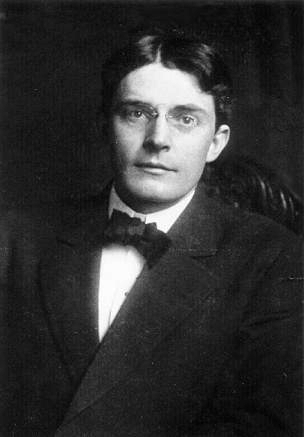
J.B. Watson is one of the controversial figures alluded to earlier. He is credited with ushering in behaviorism, and although he did push it in, he also left psychology soon after.
Watson completed his Ph.D. at the University of Chicago in 1903. By 1908, he became chair of the Psychology department at Johns Hopkins University. In 1913, he launched a critique of introspectionist methodology in his “Behaviorist Manifesto” titled, “Psychology as the Behaviorist Views it” (Watson, 1913). Watson became APA president in 1915, and in the society meeting that year he argued that psychology should adopt the methods of Pavlov to become a science of conditioned reflexes and stimulus-response learning (Watson, 1916).
Watson published some work on conditioned reflexes, but is most infamous for his “Little Albert” experiment in 1920, which was an attempt to generalize Pavlovian conditioning to humans (Watson & Rayner, 1920). This study was conducted before ethical standards for protecting human subjects in research, like those in the Belmont Report, were codified and enforced in America.
The experiment was supposed to have two phases, but only the first phase was conducted. In the baseline phase, an eleven-month-old infant (“Little Albert”) was exposed to stimuli such as a white rat, a rabbit, a dog, masks, and burning newspapers. After these exposures it was observed that the infant did not react in fear to those stimuli.
During the fear-conditioning phase, every time the infant was shown a white rat, Watson created loud sounds by striking a steel bar with a hammer. This caused the infant to become very distressed, and displaying behaviors like crying and crawling away.
Watson continued the “conditioning” procedure until the infant became afraid of the white rat even without the sound. Watson further measured the infant’s distress response to other objects that were not conditioned, demonstrating what seemed to be generalized fear-conditioning. Watson apparently planned to “de-sensitize” the infant, using an extinction procedure. However, the infant was removed from the hospital where Watson was conducting his study before the planned desensitization could take place.
Also in 1920, Watson was fired from his position at John Hopkins as part of a divorce scandal. He took an advertising job in New York and did not continue in academia. However, he continued to publish popular science books such as “Behaviorism” in 1924, as well as books on using behaviorist techniques for parenting.
Watson’s contributions to psychology have sometimes been cast in a positive light. In 1957, shortly before his death, he received the gold medal from the American Psychological Association. Proponents of the modern field of applied behavior analysis have argued that historical descriptions of Watson’s views that appear in textbooks have been inaccurate, and should be corrected so that Watson can be better appreciated (Todd, 1994). For example, in the 1970s many textbooks published claims that Watson was conducting early experiments in sex research while having an affair with his graduate student. However, historical research into those allegations have been inconclusive (Benjamin et al., 2007).
Watson has also been presented in a very negative light. For example, in the book Scientific Pollyannaism, Yakushko describes Watson as an advocate of eugenics, and that his research was “filled with what could be described as sadistic experiments on infants and young children, many of whom Watson acknowledges to be orphans or children who were institutionalized under his care at a children’s hospital.” (Yakushko, 2019). Watson was listed as a new active researcher in the “Eugenics Research Association” by the publication Eugenical News, but he was kicked out of that association when he was fired during his divorce.
Watson wrote extensively on behaviorist techniques that parents could use to raise more superior children. These writings reiterated themes from eugenics, emphasizing how superior parents can breed superior children. However, they also allowed for behaviorist interventions to play a role in helping gifted parents nurture their children into even more exceptional individuals than would be possible through genetics alone. As an example, the following quote appears in a book co-authored by Watson.
“Superior parents have no guarantee that their children will be superior. No one can predict the qualities that will arise from their combination, for millions of possibilities are equally open. Superior parents must watch and help their children with the same anxious care that others must use. Of course we know that gifted parents are much more likely to produce gifted children, inferior parents inferior children.” (Jennings et al., 1918).
Watson left academia when he was fired in 1920, but he did not stop experimenting on children. Instead, he wrote about applying his behaviorist techniques to his own children and described thought-experiments where he wished he could electrify his son Billy’s toys and then shock his other son Jimmy whenever he tried to touch them, as a way to teach him to avoid Billy’s toys (Watson, 1928). Paraphrasing from Yakushko (pg 107, Yakushko, 2019), who discusses family survivors of Watson’s experimentation and notes that his children claimed they were damaged by his behaviorist parenting. Polly Watson became an alcoholic and was regularly hospitalized for suicide attempts. John Watson died of a bleeding ulcer that he attributed to his father’s feeding schedule. William Watson published scathing personal letters about his father’s abuse in Life Magazine. Billy Watson committed suicide in his 30s. James Watson, the youngest son, became a vocal critic of his father and gave public interviews about recovering from Watson’s abuse.
6.4.1 Elements of Watson’s Behaviorism
A few versions of Watson’s “Behaviorism” are available from the internet archive. Read it here
Watson coined the term behaviorism in 1913 (Schneider & Morris, 1987; Watson, 1913) and left academia in 1920, taking up a sales position in New York City. However, he continued to express and sell his behaviorism by publishing popular science books, such as “Behaviorism” (Watson, 1924, which was published in several revisions up to 1958). The elements of his behaviorism are largely ideological and often flamboyant. They are briefly summarized with examples next.
Watson was concerned that psychology was not scientific enough. He criticized introspectionist methods because they did not provide objective and verifiable measures. He promoted Pavlov’s discovery of conditioned reflexes as the new empirical strategy that would make psychology a real science. He argued that psychology could be reduced to associative learning of stimulus-response relationships. He argued that behaviorism’s scientific goal was to establish empirical laws that would enable control and manipulation over stimulus-response learning. He envisioned behaviorism’s societal goal as creating new applied fields like behavioral engineering and a new behaviorist religion based on scientific ethics. There is a strong parallelism to the scientific utopianism of eugenics. Watson was a member of eugenics organizations, and although he later criticized aspects of eugenics (notably after his membership was removed), he offered behaviorism as a supplement rather than a wholesale replacement of eugenics. For example, eugenics focused on improving humans over generations from the genetic inheritance perspective. Watson did not deny the role of genetic influences but saw an opportunity to promote his behaviorism as the scientific way to improve humans within a generation from the environmental or learned influences perspective. In this way, nature and nurture could be controlled and manipulated through eugenics and behaviorism to create a more perfect society.
6.4.2 Watson’s stimulus-response positivism
In “Behaviorism”, Watson adopts Comte’s positivism stages to criticize psychology and advocate its replacement with behaviorism. He argues that introspective psychology had a strong religious background that invoked God concepts to explain the mind. Furthermore, appeals by psychologists to abstract entities like consciousness were vague and unscientific. From Watson’s point of view, psychology had not progressed beyond Comte’s theological or metaphysical stages. Watson then advanced behaviorism as the proper science that would replace psychology and reach the positive stage.
Watson defined behaviorism as, “a natural science that takes the whole field of human adjustments as its own…[and that while it is interested in the physiology of parts of humans and animals it]…is intrinsically interested in what the whole animal will do from morning to night and form night to morning”.
He further explains that “the interest of the behaviorist in man’s doings is more than the interest of the spectator–he wants to control man’s reactions as physical scientists want to control and manipulate other natural phenomena. It is the business of behavioristic psychology to be able to predict and to control human activity. To do this it must gather scientific data by experimental methods. Only then can the trained behaviorist predict, given the stimulus, what reaction will take place; or, given the reaction, state what the situation or stimulus is that has caused the reaction.”
6.4.3 Watson’s S-R System
In positivism, a scientific system is achieved when a phenomenon under investigation can be described and predictably controlled. Watson envisioned stimulus-response learning as a positivist system. Elements of Watson’s S-R system are described below with figures showing original text from Watson (1924)’s book.

In Figure 3, Watson stated the problem for behaviorism as finding the functional relationship between stimuli and responses, such that one could be predicted or ascertained from the other. He started with simple examples of S-R associations, and then claimed the concept could be generalized across society.
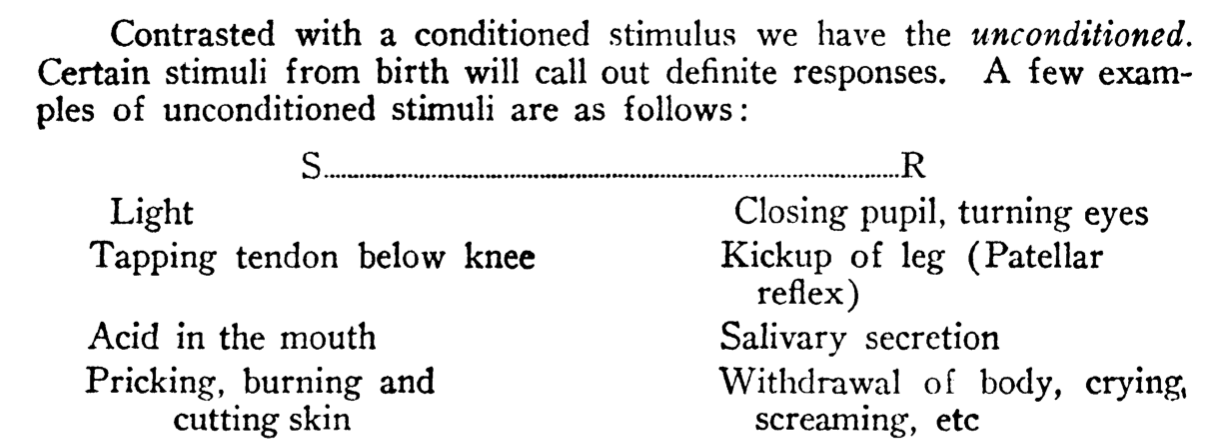
In Figure 4, Watson lists simple S-R associations, like the patellar knee reflex, that do not require formation through learning.

In Figure 5, Watson suggests that Pavlovian conditioning could form new S-R associations through experience. He presented conditioning as a general process that could cause wide ranges of behaviors to come under stimulus control.
Watson’s S-R system was more like speculative fiction than a fully worked out system in the positivist tradition. He identified terms like stimuli and response and made grand claims about functional relationships between them, but did not supply a detailed mathematical analysis of lawful connections between stimuli and responses. Instead, he jumped straight to envisioning how future society could control its citizenry using behavioral engineering.


In Figure 6, Watson formulated societal-level manipulations in terms of stimulus-response questions and was hopeful that behaviorism could help predict the outcomes of such interventions. Similarly, he envisioned desired outcomes for society and implied that behavioral engineering could devise the appropriate stimuli to elicit the behaviors he deemed desirable.

Finally, Watson promoted behaviorism as more than just the correct scientific approach to psychology. He billed it as an academic social movement in the tradition of scientific utopias that was sweeping the nation. For example, in Figure 7 Watson describes how psychology, philosophy, ethics, social psychology, sociology, religion, and psychoanalysis were all either adopting behaviorist frameworks or gradually disappearing if they were not.
6.5 Tolman’s “Purposive” behaviorism
“All students agree as to the facts. They disagree, however, on theory and explanation.” – Tolman, 1948 (Tolman, 1948)
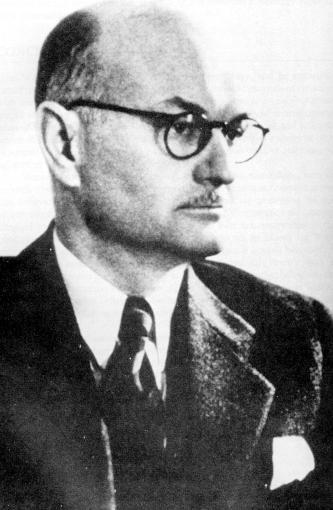
Edward C. Tolman’s (1886-1959) flavor of behaviorism incorporated elements that are common in modern cognitive psychology. In 1932, he wrote “Purposive Behavior in Animals and Men” (Tolman, 1932), which summarizes his research and views on behaviorism. In presenting his view, Tolman points out that numerous authors, such as “Holt, Perry, Singer, de Laguna, Hunter, Weiss, Lashley” had been developing their own versions of behaviorism, and refers to Roback’s “Behaviorism and Psychology”, for “the best analysis and bibliography of the different varieties of behaviorism extant to 1923”. This diversity of views underscores the difficulty of treating the period of behaviorism as a single monolithic entity. Instead, much like there are numerous views on cognition today, there were numerous views on behaviorism. Similarly, it is worth noting that there were non-behaviorist views on psychology and non-behaviorist research was ongoing throughout the so-called period of behaviorism.
After some training in Germany, Tolman received his Ph.D. at Harvard under Edwin Holt in 1915, who had worked under Hugo Munsterberg. He is well-known for his research on maze-learning in rats, which is the focus of this section.
6.5.1 Molar definition of behavior
Tolman suggested that Watson had given a “molecular” definition of behaviorism that described important units like stimulus and response, but reduced behavior to “strict physical and physiological muscle-twitches”. Tolman 6 argued in favor of a “molar” definition of behaviorism that describes holistic behaviors as things in and of themselves that could be studied, irrespective of their “molecular” units. To quote from Tolman:
“An act qua ‘behavior’ has distinctive properties all its own. These are to be identified and described irrespective of whatever muscular, glandular, or neural processes underlie them. These new properties, thus distinctive of molar behavior, are presumably strictly correlated with and, if you will, dependent upon, physiological motions. But descriptively and per se they are other than these motions.”
“A rat running a maze, a cat getting out of a puzzle box, a man driving home to dinner, a child hifing from a stranger, a woman doing her washing or gossiping over the telephone, a pupil marking a mental test sheet, a psychologist reciting a list of nonsense syllables, my friend and I telling one another our thought and feelings– these are behaviors (qua molar). And it must be noted that in mentioning no one of them have we referred to, or, we blush to confess it, for the most part even known, what were the exact muscles and glands, sensory nerves, and motor nerves involved. For these responses somehow had other sufficiently identifying properties of their own.”
Watson’s stimulus-response behaviorism identifies S and R as the objective units of analysis, but neglected or deliberately ignored other aspects such as the purpose or significance of the behavior in question, and the potential cognitive processes that intervene between the perception of a stimulus and the final production of a response.
6.5.2 Purposive and cognitive determinants
In suggesting that behavior should be studied as a holistic molar unit in itself, Tolman further argues that additional terms are necessary to describe the purposes and cognitive mechanisms of behavior. In some sense, Tolman’s ideas appear to revisit the intangible mental operations that inspired behaviorist critiques of “mentalist” psychology. However, Tolman also proceeds in the positivist tradition and is careful to clarify that his new terms are intended only as descriptors. For example, just like it would be okay to describe a stimulus as being “green” without implying anything about an inner mental experience of seeing a green object, Tolman thought it would be useful and necessary for a science of behavior to describe behaviors as having purposes and cognitions–but only for descriptive purposes, and not to imply inner mental processes.
The following quotes show Tolman building his argument that new terms for purpose and cognition were necessary to fully describe behavior.
“Behavior in our sense, always seems to have the character of getting to or getting-from a specific goal object, or goal situation. The complete identification of an single behavior act requires, that is, a reference first to some particular goal object or objects which that act is getting to, or, it may be, getting from, or both. Thus, for example, the rat’s behavior of”running the maze” has as its first and perhaps most important identifying feature the fact that it is a getting to food”.
“To sum up, the complete descriptive identification of any behavior act per se requires descriptive statements relative to (a) the goal-object or objects, being got to or from, (b) the specific pattern of commerces with means-objects involved in this getting to or from, and (c) the facts exhibited relative to the selective identification of routes and means-objects as involving short (easy) commerces with means-objects for thus getting to or from”
“But surely any”tough minded” reader will by now be up in arms. For it is clear that thus to identify behaviors in erms of goal-objects, and patterns of commerces with means-objects as selected short ways to get to or from the goal-objects, is to imply something perilously like purposes and cognitions. And, this surely will be offensive to any hard headed, well brought up psychology of the present day”
“And yet, there seems to be no other way out. Behavior as behavior, that is, as molar, is purposive and is cognitive. These purposes and cognitions are of its immediate descriptive warp and woof. It no doubt is strictly and completely dependent upon an underlying manifold of physics and chemistry, but initially and as a matter of first identification, behavior as behavior reeks of purpose and of cognition.”
“Finally, however, it must nonetheless be emphasized that purposes and cognitions which are thus immediately, immanently, in behavior are wholly objective as to definition. They are defined by characters and relationships which we observe out there in the behavior. We, the observers, watch the behavior of the rat, the cat, or the man, and note its character as a getting to such and such by means of such and such a selected pattern of commerces-with. It is we, the independent neutral observers, who note these perfectly objective characters as immanent in the behavior and have happened to choose the terms purpose and cognition as generic names for such characters.”
6.5.3 The rat in the maze
Tolman formulated his behaviorism in the context of laboratory research on maze-running behavior in the white rat. His 1932 book (Tolman, 1932) argues for the inclusion of goals and cognitions in a descriptive science of behavior, and it also provides a substantial review of maze-running research conducted up to that date. Many other researchers, including J. B. Watson, used maze-running procedures to study behavior.
Maze-running procedures were similar to Thorndike’s puzzle boxes. Typically, an animal like a white rat was placed in a physical maze, and then its behavior was observed as it moved about the maze, usually in search of a food reward. More importantly, manipulations were introduced to test ideas about the processes underlying the animal’s abilities to navigate the maze. Tolman ran experiments and assembled evidence from other labs to build evidence in favor of his view that animals had goals and cognitions (in his behaviorist sense). Some examples of the procedures and findings used to make inferences about purposive and cognitive behavior in the white rat are next.
6.5.3.1 Purposive behavior
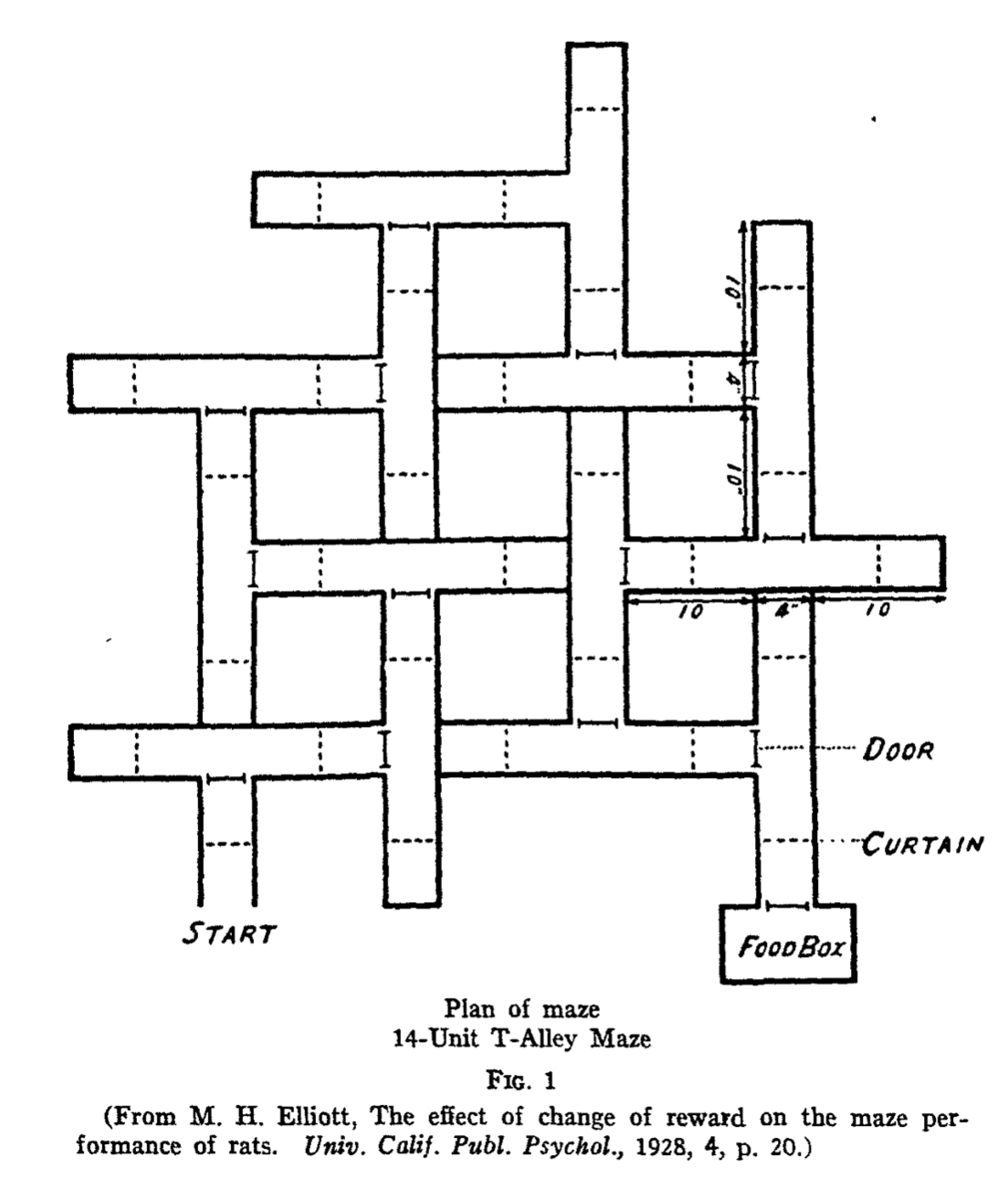
Tolman argued that behaviors were obviously goal-driven and should be described in terms of goals and purposes. To support this argument, he showed that maze running behavior could be influenced by apparent goals or motivational drives. Figure 9 depicts one of Tolman’s “Alley Mazes”.
The maze had a starting point where the rat entered, and an endpoint where it could receive food reward. In between, the rat had to navigate the maze, which contained several corridors, doors, and curtains, and many “blind alleys” leading to an empty wall. In general, rats explore the maze and eventually find the food reward. The behavior of the rat can be measured in different ways, such as the total amount of time taken to successfully navigate the maze. In the following experiment, Tolman measured the number of errors an animal made during navigation. An error is counted whenever the rat enters a blind alley entrance.
In one experiment (Tolman & Honzik, 1930), Tolman manipulated the level of hunger and amount of reward. Rats ran the maze when they were either very hungry or not very hungry. Additionally, for both groups, food was either given as a reward at the end of the maze, or food was not given.
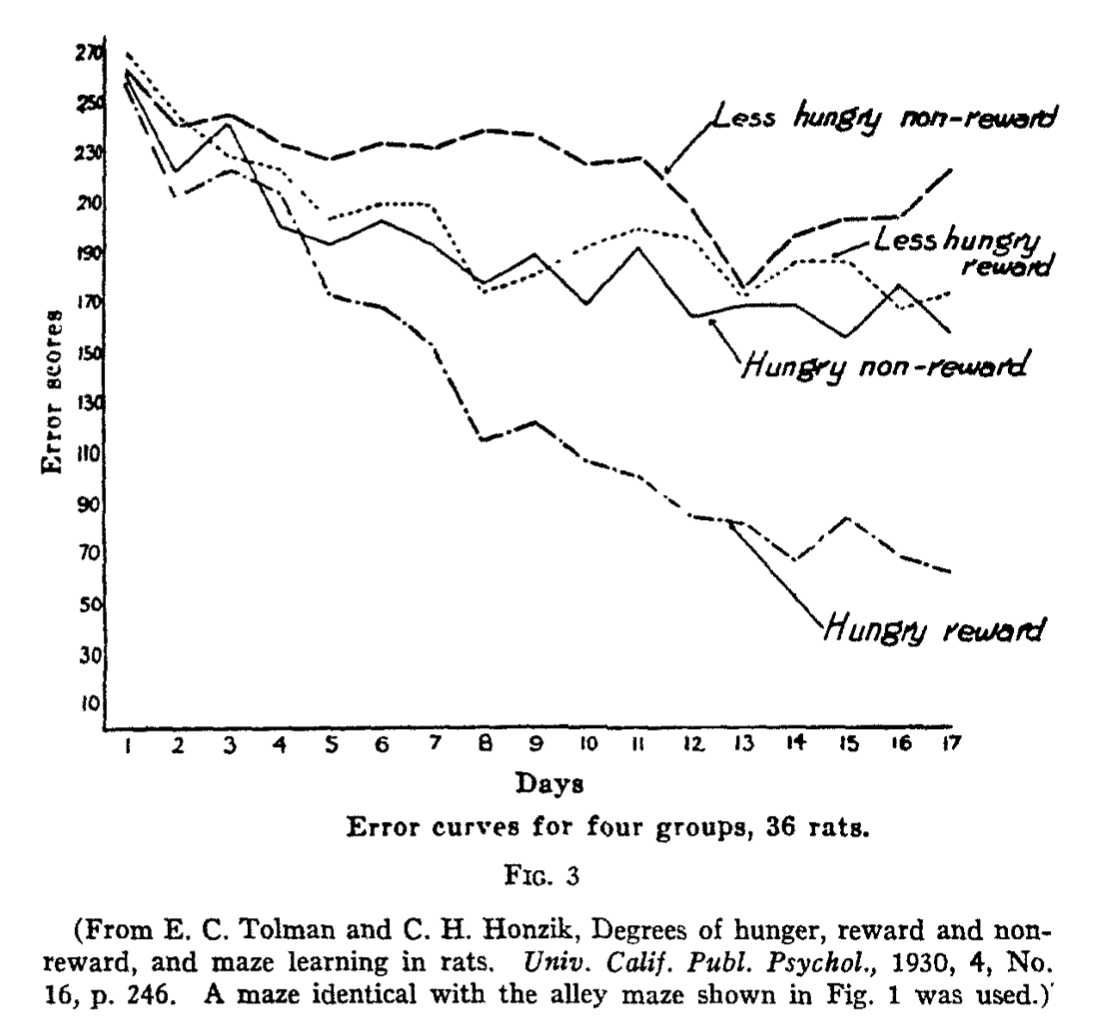
The results of the experiment are shown in Figure 10. In general, all groups of rats showed fewer errors across the days of the experiment: on day one, the lines started with a high number of errors and trended downward over days to a lower number of errors. This means that the rats made fewer wrong turns as they gained experience with navigating the maze over time.
More specifically, the hunger and reward manipulations clearly influenced the number of errors that the rats made over days. Tolman interpreted the data as being consistent with goal-driven or purposive behavior. The error scores for the “hungry reward” group showed the greatest reductions over days compared to the other groups. According to Tolman, these rats were driven by hunger and motivated by the reward they would receive at the end. With practice over time, they seemed to learn how to navigate the maze efficiently in order to obtain the food quickly and without making incorrect turns.
By comparison, the “Hungry non-reward” rats showed smaller reductions in errors across days. These rats were driven by hunger, but they were not as motivated to get to the end of the maze because there was no food at the end. Similarly, both of the “less hungry” groups even smaller reductions in number of errors over time. This was consistent with those rats having little drive to search for food in an efficient manner.
6.5.3.2 Cognitive Behavior
Tolman argued that behavior should be described in terms of cognitive acts. He used discrimination and choice behavior in rats as evidence. The form of the argument was first to demonstrate that a rat could distinguish between two options (discrimination), and then show that the rat’s behavior showed a preference (choice) toward one of the options. This kind of behavior was characterized as being cognitive because it implied a process of considering the costs and benefits of different options, and making choices to take actions that would help the animal achieve its goals.
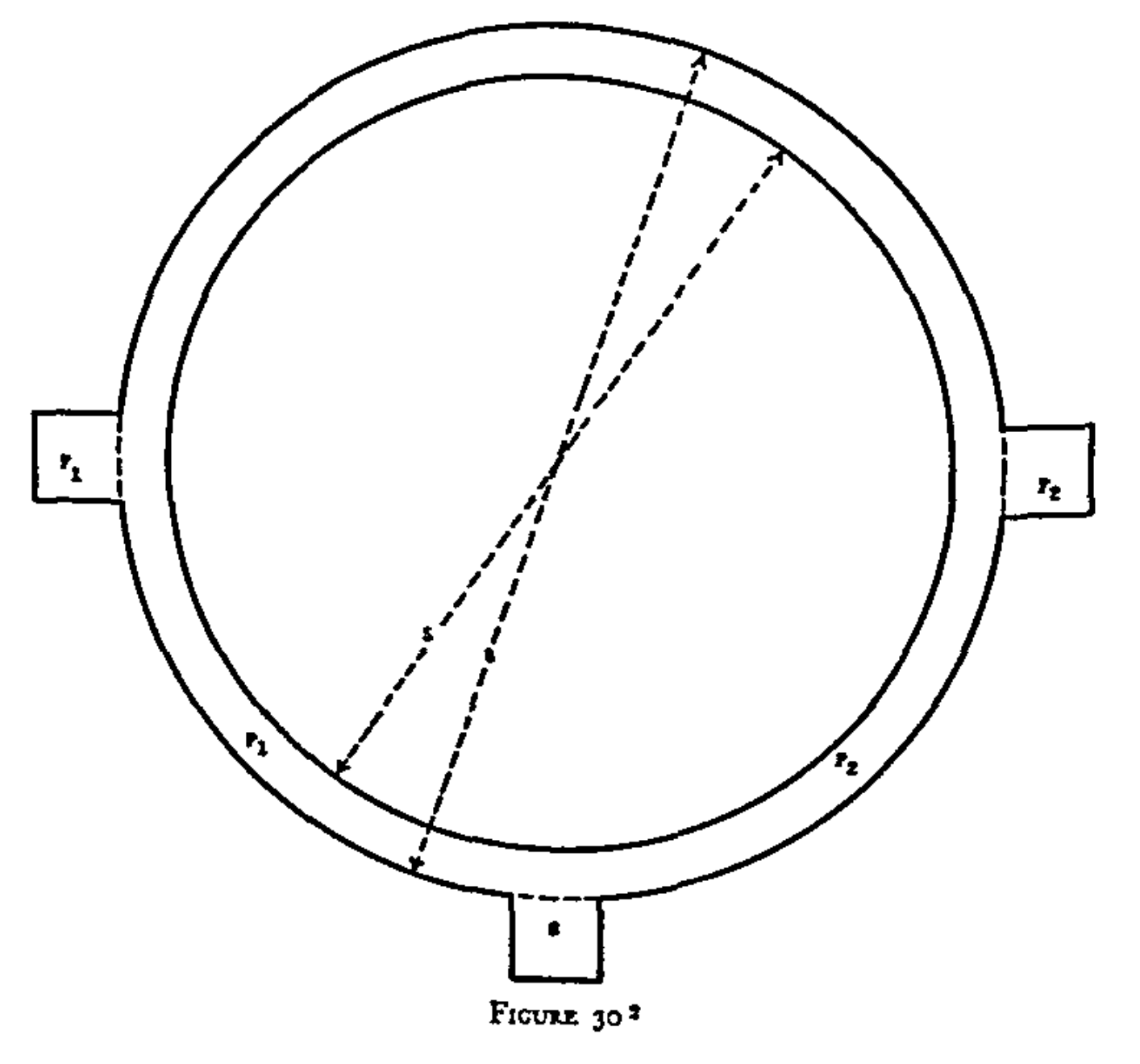
Tolman credits De Camp (De Camp, 1920) with connecting the results of a distance discrimination experiment to the argument that behavior should be described with cognitive features. Figure 11 shows De Camp’s circular maze. The rat entered the maze at the bottom starting point. The maze had two rooms on the left and right of the circle that could contain food. In the first phase, the right room was blocked, and food could be found in the left room. The rats could either go the short way (turn left) or the long way (turn right and go around the circle). De Camp showed that with practice, the rats showed a preference for the shortest path. In a second phase, the left room was blocked, and the right room contained the food. Again, after practice, the rats showed a preference to turn right and take the shortest path to the food. This behavior was aptly described as cognitive because the rats appeared to be weighing the option to go the long or short way and choosing the shortest way to achieve their goal.
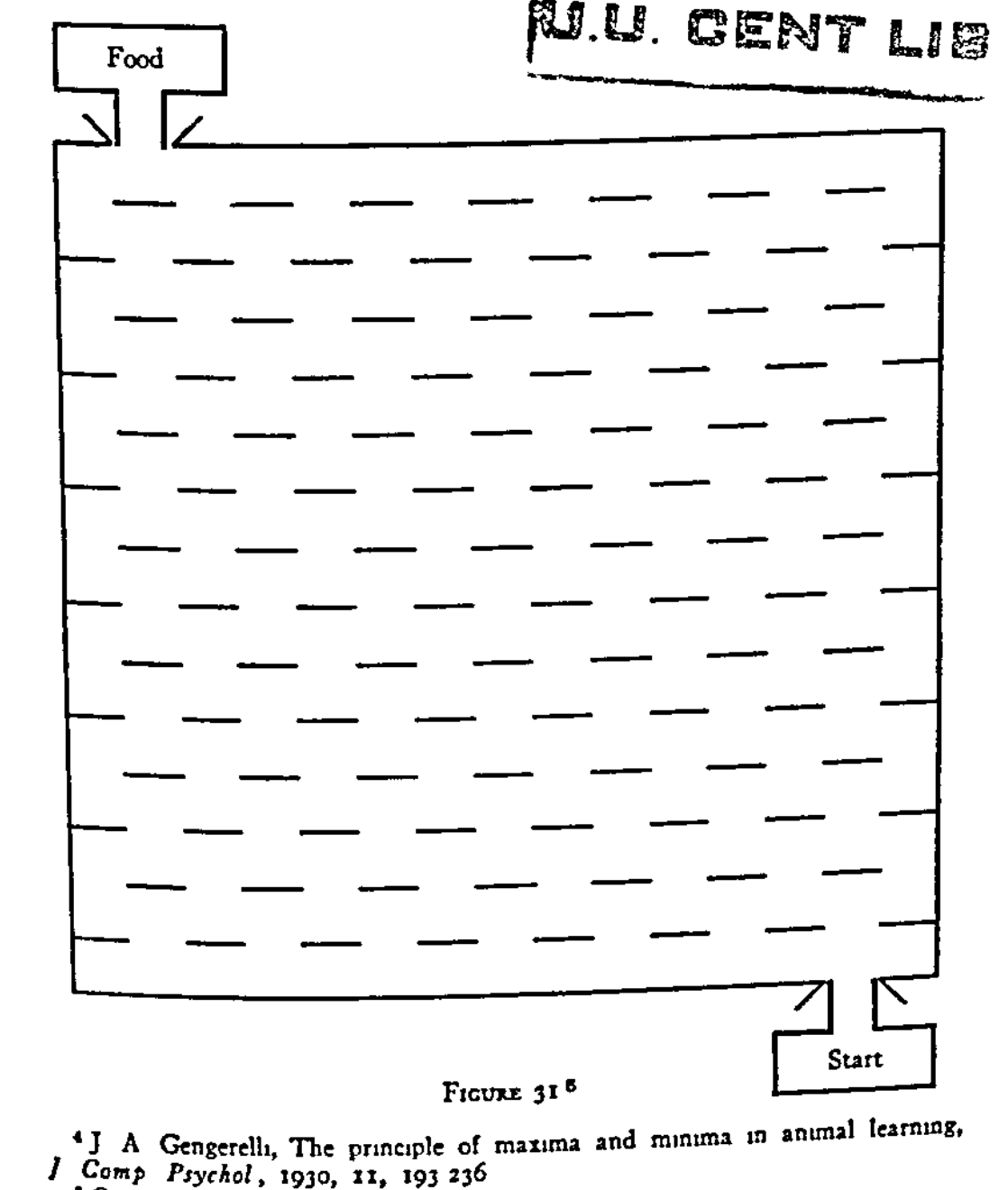
Tolman points to another interesting experiment by Gengerelli (Gengerelli, 1930), showing that rats can learn to take the shortest or most efficient path through a maze. Figure 12 shows Gengerelli’s maze, which looks like a bean machine. The maze included numerous choice points where a rat could decide to turn left or right and take an open pathway or not. For example, imagine how many ways the maze could be solved by drawing a line from the start to the finish. There are many ways, and some are longer than others. Gengerelli showed that, given multiple attempts, rats will begin taking shorter paths to get the food reward at the end.
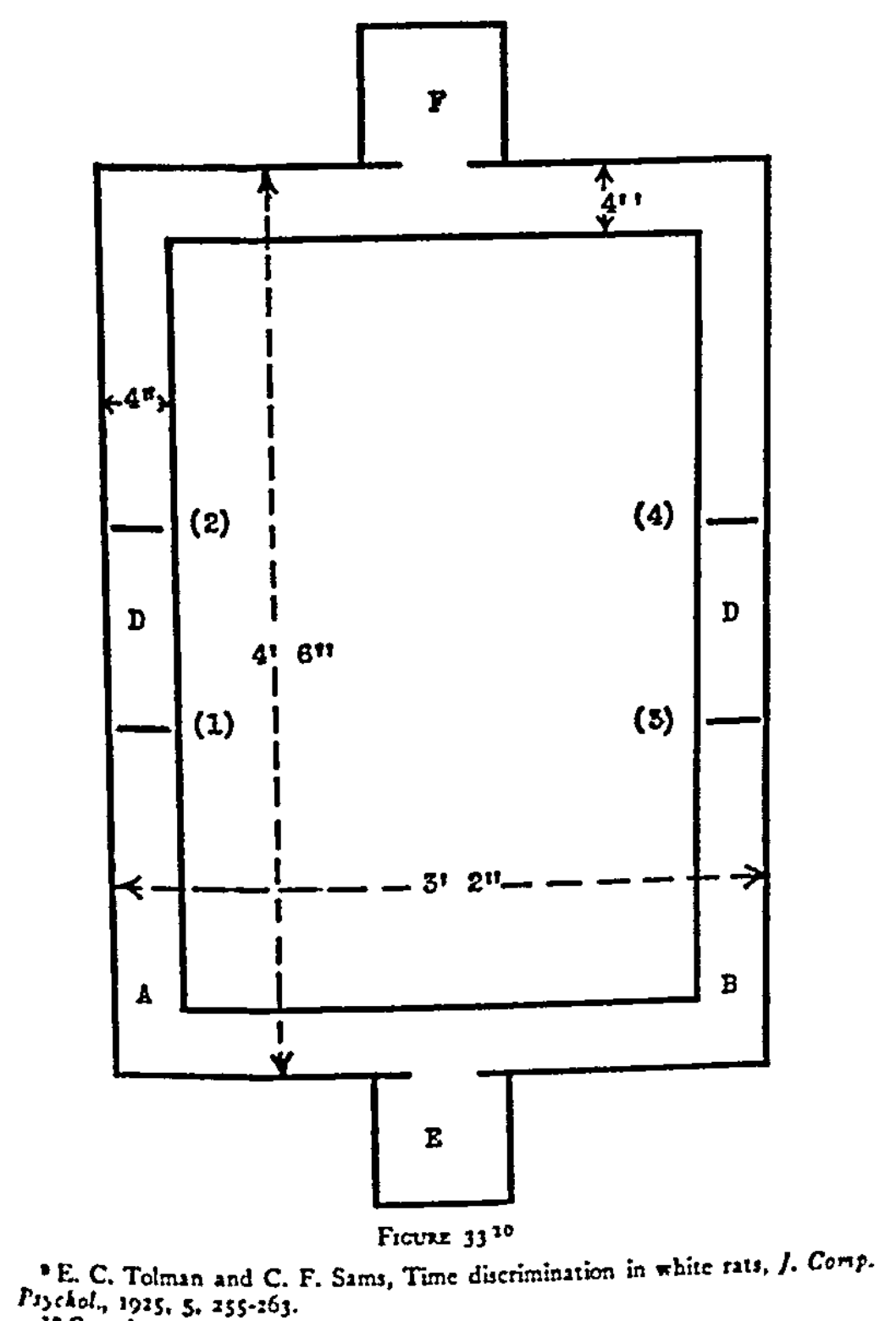
As a last example, Tolman (Sams & Tolman, 1925) showed that rats were capable of temporal discrimination and appeared to make choices while navigating a maze that reduced the amount of time taken to get a food reward. Tolman’s maze for temporal discrimination is shown in Figure 13.
The rats began at the entrance (E) and attempted to find the food in the room on the other side (F). However, when the rats took the corridor A to the left, or corridor B to the right, they were detained for varying durations in the “detention” rooms (D) on both sides of the maze. For instance, rats would be detained for one to two minutes on the left side, or three to four minutes on the right side. After the initial phase where rats encountered the delays, they were allowed to navigate the maze without being detained. The rats exhibited a preference for taking the route associated with the shortest temporal delay.
6.5.4 Tolman’s inheritance project: A rat model of eugenics
Animals like rats have been used in research for many purposes. The animal may be an object of the research in its own right or used as a model example to investigate something else, or both. For example, rats are commonly used as models for human disorders such as eating disorders and schizophrenia. One goal of research using animal models of disorders is to develop cures for the disorder in rats that could generalize to humans.
Tolman conducted animal research using rats that had elements of both styles of research. He was interested in the behavior of rats as an object of study in its own right but also as a model in at least two respects. First, Tolman was interested in using rats as a model for building a descriptive science of behavior that could be generalized to other animals. In this first respect, Tolman used his maze-running experiments to argue in favor of expanding the terms in the descriptive science of behaviorism–specifically, behaviorism should include terms for describing the purposive and cognitive aspects of behaviors. Second, Tolman initiated another line of maze-running experiments that I will describe as Tolmans’ rat model of eugenics.
One aim of Galton’s eugenics was to measure differences in eugenically desired traits (like intelligence), and then selectively breed humans to increase those traits (assuming they had a genetic basis) over time. Tolman and his student Robert Tryon attempted something similar in rats (for a review see, Innis, 1992). They selectively bred rats for maze-running ability over generations. On the one hand, these experiments could be described without the term eugenics, and more neutrally described as research on the genetic bases of maze-running behavior in rats. On the other hand, the connection to eugenics is clear enough, and was not limited to Tolman. For example, early comparative psychologists Edward Thorndike and Robert Yerkes were prominent eugenicists. Thorndike described his puzzle box research as a preliminary step toward measuring individual differences in animal intelligence.
Like Thorndike, Tryon analogized the maze-running procedure as a tool to measure individual differences in rat intelligence. Measures of time and efficiency in navigating the maze were used as proxies for rat intelligence, and not surprisingly, there were reliable individual differences in rat maze-running performance (Tryon, 1942). Tolman first attempted a breeding program to create “bright” versus “dull” strains of maze-running rats (Tolman, 1924). In this work, Tolman exposed rats to a maze and measured individual differences in maze-running efficiency. He then bred “bright” rats together, and separately bred “dull” rats together. He did this over two generations, so there was a parent generation, an \(F_1\) generation and an \(F_2\) generation. Tolman reported that selective breeding did show differences in maze performance in the first generation, but not in the second generation. His student Tryon repeated a selective breeding experiment over 11 years and many more generations and found similar results (Tryon, 1940).
6.5.5 Cognitive maps in rats and men
To wrap up our discussion of Tolman, consider his 1948 paper in Psychological Review called “Cognitive maps in rats and men” (Tolman, 1948). This paper reflects Tolman’s thoughts 16 years later, as he reviews maze-running research up to 1948. He shifts away from his previous descriptive stance on cognitive aspects of behavior. In 1932, Tolman carefully argued that words like “cognitive” or “purpose” were merely descriptive terms for behavior and not intended to imply the existence of internal mentalistic-type processing. However, in 1948, Tolman embraces a more cognitive interpretation, using “cognitive” to refer to a process or set of operations between stimulus and response that is crucial to behavior. Specifically, Tolman argues that rats develop cognitive maps of the mazes they navigate. This suggests that rats have internal map-like representations of the maze, which they use to guide their choices while running through it. One line of evidence supporting Tolman’s position comes from studies on latent learning.
6.5.5.1 Latent-learning as evidence for cognitive maps

Tolman credits Bodgett (Blodgett, 1929) with introducing the concept of latent learning to maze-running experiments. Latent learning refers to something an animal apparently learned without expressing the learning in performance. Bodgett demonstrated latent learning by giving three groups of rats different kinds of experience with running the maze shown in Figure 14.
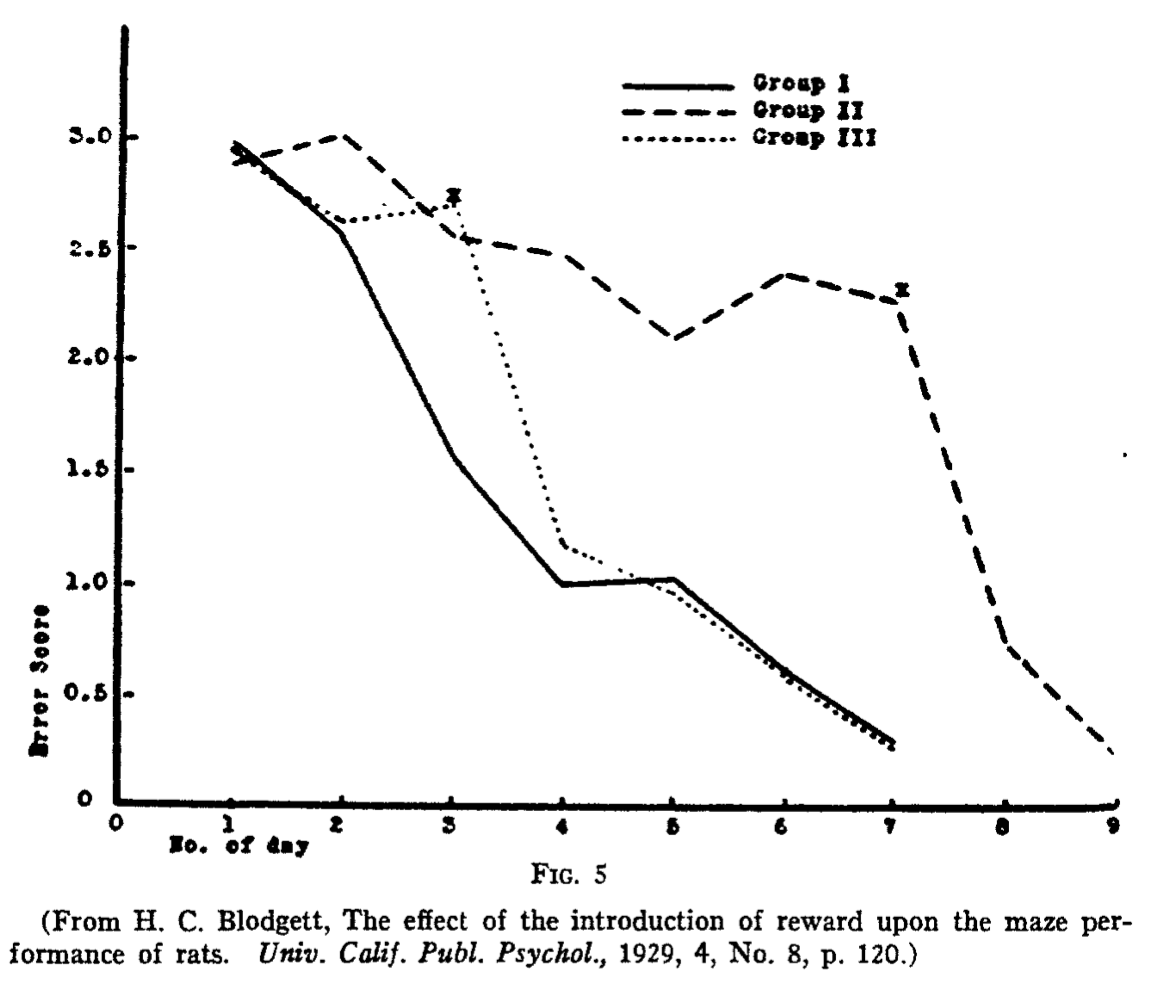
Figure 15 shows the results from the study. Group I (represented by the solid line) always received a food reward in the chamber at the end of the maze. The results indicate that this group made fewer and fewer errors as the days progressed. Group II (the dotted line) did not receive a food reward at the end of the maze until day three, which is marked with an X. Up until day three, group II did not demonstrate a significant reduction in the number of errors. However, after day three, they exhibited a substantial decrease in errors. Group III (the dashed line) did not receive a food reward at the end of the maze until day 7. This group did not show significant decreases in errors until after day 7 when they displayed a dramatic decrease in errors. Here is a quote from Tolman that illustrates how he connected these findings with the notion of a cognitive map:
“It will be observed that the experimental groups as long as they were not finding food did not appear to learn much. (Their error curves did not drop.) But on the days immediately succeeding their first finding of the food their error curves did drop astoundingly. It appeared, in short, that during the non-rewarded trials these animals had been learning much more than they had exhibited. This learning, which did not manifest itself until after the food had been introduced, Blodgett called”latent learning.” Interpreting these results anthopomorphically, we would say that as long as the animals were not getting any food at the end of the maze continued to take their time in going through it – they continued to enter many blinds. Once, however, they knew they were to get food, they demonstrated that during these preceding non-rewarded trials they had learned where many of the blinds were. They had been building up a ‘map,’ and could utilize the latter as they were motivated to do so”.
6.5.5.2 Implications for society
Tolman’s work was also in the tradition of positivism. One aspect of that tradition involved developing descriptive systems for the natural phenomena under investigation. In his behaviorism days, Tolman argued that cognitive terminology should be used to describe behaviors but not to imply any cognitive operations. Later on, he showed an inclination toward cognitivism, which involved legitimizing so-called cognitive processes as a topic of scientific inquiry. In Tolman’s case, he suggested that cognitive maps were entities or operations, not just descriptors, that should be considered as units of study.
Themes of scientific utopianism in behaviorism are again visible. Watson’s vision of behaviorism included grandiose claims about how society would be improved by behaviorism. Tolman was more circumscribed than Watson, but in the positivist tradition chose to devote the final pages of his psychological review paper to speculate on how his concept of cognitive maps in rats could be generalized to humans for the benefit of society. Whatever his prior views were on eugenics, and considering that he was writing in 1948 after eugenics was in decline following the atrocities of World War II, his recommendations for improving society were much more inclusive by comparison. He likened navigating a maze to living in the world, and suggested that people needed to acquire “comprehensive” and rational maps of the world. People for too long had acquired narrow-minded maps and pursued courses of action that could lead to violent conflict. Tolman wrote:
“the child-trainers and the world-planners of the future can only, if at all, bring about the presence of the required rationality (i.e., comprehensive maps) if they see to it that nobody’s children are too over-motivated or too frustrated. Only then can these children learn to look before and after, learn to see that there are often round-about and safer paths to their quite proper goals–learn that is to realize that the well-beings of [all people] are mutually interdependent”.
6.6 Hull’s mathematical behaviorism
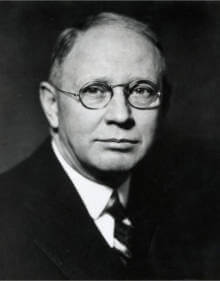
Clark L. Hull’s (1884-1952) flavor of behaviorism was aligned with the positivist tradition, emphasizing the use of mathematics to precisely define functional relationships between behavioral units. In the positivist tradition, a scientific theory is considered provisional and practical. It is valuable if it proves effective for the purposes of manipulation and control. While mathematical formulations are not explicitly required, they often serve as helpful tools for describing functional relationships in order to make accurate predictions.
Hull also worked during the eugenics era in American psycholgoy. He was recruited to Yale in 1929 by then president James R. Angell, who was previously a psychologist running a nationally recognized eugenics laboratory. Hull was recruited into Yale’s burgeoning new enterprise, the Institute for Human Relations (IHR). Hull was hired as a mental tester, and among his first grant applications to the institute was a program of eugenics (see also the role of eugenics in the early Yale psychology department (Doyle, 2014) and more on Hull’s influence in the IHR (Morawski, 1986)).
To contrast with Hull, Watson did not attempt to formulate any precise mathematical theory linking the terms in his system. Watson used simple terms like stimulus and response, and put them in a mock “algebra”. For example, one could state “S -> R?”, and solve the equation by experimentally determining what responses \(R\) were caused by some stimuli \(S\).
Hull’s work is one example of attempting both to specify descriptive terms for a science of behavior (terms like stimulus and response, as well as terms for drives and motivations), and to use math to describe supposedly lawful patterns linking terms in the system. There was hope in this exercise that behavior itself was lawful. If so, behavior could be observed and fitted to the terms in the equations. Then, assuming the equation correctly described the lawful aspects of the behavior, it was supposed to predict how behavior would unfold under given circumstances specified by the equation.
Here is an example 7 of Hull’s formula for behavior described in “Principles of Behavior” (Hull, 1943):
\(_SE_R = _SH_R × D × V × K\)
Where:
\(_SE_R\) is an excitatory potential (likelihood that the organism would produce response r to stimulus s),
\(_SH_R\) is the habit strength (derived from previous conditioning trials),
\(D\) is drive strength (determined by, e.g., the hours of deprivation of food, water, etc.),
\(V\) is stimulus intensity dynamism (some stimuli will have greater influences than others, such as the lighting of a situation)
\(K\) is incentive (how appealing the result of the action is).
Hull’s mathematical theory did not succeed in explaining and predicting behavior in any general sense. However, it did succeed in inspiring other psychologists to adopt mathematical formulations to describe psychological processes. Mathematical and computational models are now a routine part of theorizing in cognitive psychology.
6.7 Skinner’s “Radical” Behaviorism

Burrhus F. Skinner (1904–1990) received his Ph.D. at Harvard in 1931, where he spent the majority of his later academic career. Skinner had a profound impact on psychology and cognitive psychology, both in terms of his ideas and the number of graduate students he mentored who would continue to shape the field. Skinner is often associated with the term “radical behaviorism,” and although he did refer to his work this way on occasion, the term was more broadly used to describe behaviorist ideas as “radical” in relation to other ideas in psychology (for more, see Schneider & Morris, 1987).
Skinner is well-known for introducing the method of operant conditioning, which he distinguishes from classical conditioning shown by Pavlov. Skinner uses the terms type R learning for operant conditioning, and type S learning for Pavlovian conditioning. In this section, we will examine the method of operant conditioning, a few major findings from operant conditioning research, and Skinner’s attempt to create a descriptive system of behavior in the positivist tradition.
6.7.1 Operant Conditioning
Skinner distinguished between Type-S and Type-R forms of learning. In Type-S Learning, an S-R relationship is already established before conditioning begins. For example, the unconditioned stimulus (e.g., food) elicits a response (e.g., salivating) before any acquisition phase. Through the process of pairing a neutral stimulus (e.g., a tone) with the unconditioned stimulus, the neutral stimulus can acquire the ability to trigger the response on its own.
In Type-R learning, S-R relationships may not exist or may not be known prior to conditioning. Skinner pointed out that many responses in animal behavior occur with different frequencies, without being triggered by any obvious stimulus in the environment. He termed these behaviors operants. For example, a rat placed in a box will show many behaviors (e.g., walking, licking, scratching, sniffing, and so on). These individual behaviors will repeat over time, and some behaviors will occur more frequently than others. All of these behaviors could be considered operants, which are the repertoire of behaviors that an animal can perform. Before Type-R learning, the operant behavior could be said to have some probability of occurring on its own. The goal of Type-R learning was to gain control over the operant behavior, such that the occurrence and frequency of the behavior could be made predictable.
Operant conditioning is commonly used to train behaviors in animals such that they perform a desired action in response to a stimulus, or perform the action in a predictable manner in a given situation. For example, I accidentally conditioned our two cats Coco-Max, and Mr. Ernie Cactus, using Type-R learning. Both cats show the operant behavior of sometimes running into the living room. They do this at least a few times every day, and they did this before their crinkly bag of cat snacks were kept in a drawer in the living room.
When I give the cats snacks, I take the bag out, open it up, and hand out the snacks. The bag makes a distinct crinkly noise, just like the sound of the treats when the bag is shook. Since we adopted them, the cats have been given many snacks in the living room. As a result of this operant conditioning procedure, the running into the living room behavior is now very much under stimulus control. It appears that my cats have a keen sense of hearing, because whenever they hear the drawer move a little bit, or the bag crinkle or shake, they come galloping into the living room from any corner of the apartment. They know it is time for treats.
6.7.1.1 Lever pressing in the Skinner box
Skinner demonstrated operant conditioning in rats using a “Skinner-box” and a lever-pressing device. Unlike Thorndike’s puzzle boxes, where animals demonstrated learning by escaping the boxes as quickly as possible, Skinner’s boxes were constructed to contain the animal and create an environment where a particular behavior could be efficiently observed and measured.
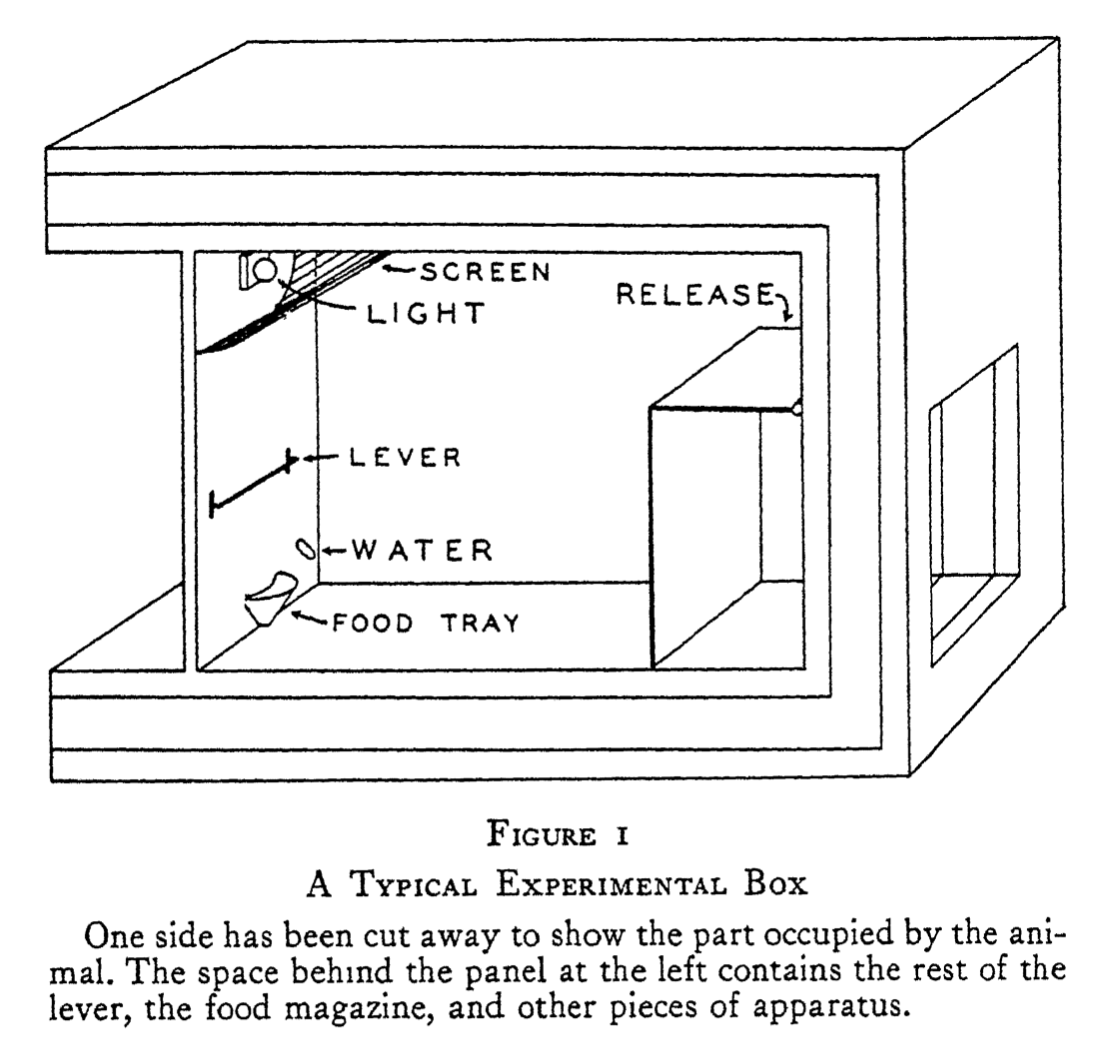
Figure 18 shows the Skinner box had space for a single rat to move about, and mechanisms for water and food delivery. The box also contained a lever the animal could press in order to receive food reward (subject to experimenter control). And, the box was set up to record any lever presses the animal made.
Lever-pressing is a good example of an operant behavior that occurs without any prior conditioning. For example, Skinner noted that rats placed into his box for the first time would press the lever sometimes, even though the box was not associated with any food reward, and even though pressing the lever did not cause any food to be delivered. In other words, rats spontaneously pressed the lever sometimes. As a result, lever-pressing was a convenient operant behavior for Type-R conditioning.
Skinner assumed that operant behavior, like pressing a lever, could become reinforced if it was paired with a reward. For example, if the lever-pressing behavior was paired with a food reward, Skinner assumed that the food would reward the animal for the behavior. This would lead to the behavior being reinforced, such that the animal would increase the lever-pressing behavior. However, in order for reinforcement to occur, the behavior had to take place and be rewarded. For example, lever-pressing would be difficult to condition if the animal didn’t press the lever sometimes.
Skinner’s procedure for conditioning lever-pressing was very simple. He put rats in the Skinner box and measured how many times they pressed the lever over time without any reward. This established a baseline frequency for the spontaneous occurrence of the operant behavior. Then, the lever was connected to food delivery. Whenever the animal pressed the lever, it received a food pellet. Skinner then observed the animal and measured each of the lever-presses over time.

Figure 19 shows an example of Skinner’s findings in a simple operant conditioning procedure. The Y-axis shows the total number of lever presses, and the X-axis shows time in minutes. The line represents lever-pressing behavior over time. The rat pressed the lever for the first time after 5 minutes inside the box and then received a food reward. Then it waited a long time (almost an hour) and pressed the lever a second time, and then waited again and pressed a third and fourth time. Look what happens after the fourth press. The line veers up, indicating that the rat began pressing the lever at a much higher rate.
This is an example of operant conditioning. Prior to conditioning, the lever-pressing behavior occurred spontaneously and not very often. However, in the setting of the Skinner Box, and when lever-pressing was paired with a food reward, the animal began showing the lever-pressing behavior with a great deal of regularity. In this sense, as a result of the conditioning procedure, the lever-pressing behavior is said to have come under experimental control.
6.7.1.2 Interpreting a cumulative response graph
Skinner had several reasons for choosing lever-pressing as a behavior to investigate in the laboratory. One reason was convenience. Lever-pressing was easy to measure; rats exhibited the behavior spontaneously, and the behavior could be conditioned through Type-R learning. The overarching reason was to construct a descriptive theory of behavior (again, in the positivist tradition), starting with lever-pressing as a very simple model of other behaviors. To appreciate these larger aims, let’s take a closer look at the graphs of lever-pressing behavior over time.
Skinner usually plotted responses over time in a cumulative graph. Cumulative means that the line represents the accumulation of responses over time. In other words, at each point in time on the X-axis, the vertical position of the line on the Y-axis indicates the sum total number of responses occurring up to that point in time.

Importantly, the slope of the line in the graph has a special meaning: it represents the rate of responding or response rate. The rate of responding is a ratio of the number of responses divided by the amount of time. For example, in Figure 20 the first 4 responses occurred in about 120 minutes, so the response rate could be calculated as \(4/120 = .033\) (responses per minute). Notice that the line in the graph up to the 4th response has a shallow slope, this indicates a low rate of responding (e.g., only .033 responses per minute). After the fourth response, the slope of the line becomes steeper, indicating a higher rate of responding. By rough visual inspection of the graph, it looks like close to 100 lever presses were made in about 30 minutes, or a response rate of \(100/30 = 3.33\) (responses per minute).
6.7.2 Reflex strength: A descriptive system
Skinner used lever-pressing behavior in the white rat as a convenient, simple behavior that he could exhaustively study as a model system, which he intended to generalize to other behaviors and animals. His book “The Behavior of Organisms” (Skinner, 1938) describes many of his experiments and findings but also motivates and describes his positivist approach to behaviorism. Skinner’s goal was not to explain behavior, but instead, to create a system for describing features and laws of behavior. If Skinner could succeed in providing a comprehensive description of how to control a simple behavior, like lever-pressing, and if other behaviors were basically like lever-pressing, then system may be generalized to describe and control other behaviors.
We review Skinner’s system in more depth because it represents an approach to science that can lead to the prediction and control of natural phenomena without explaining the mechanisms of the phenomena. Skinner’s descriptive approach remains very common in cognitive psychology.
Figure 21 shows an example of the descriptive nature of Skinner’s system. The figure is a cartoon summary of how white rats typically behave in the Skinner box under different conditions.
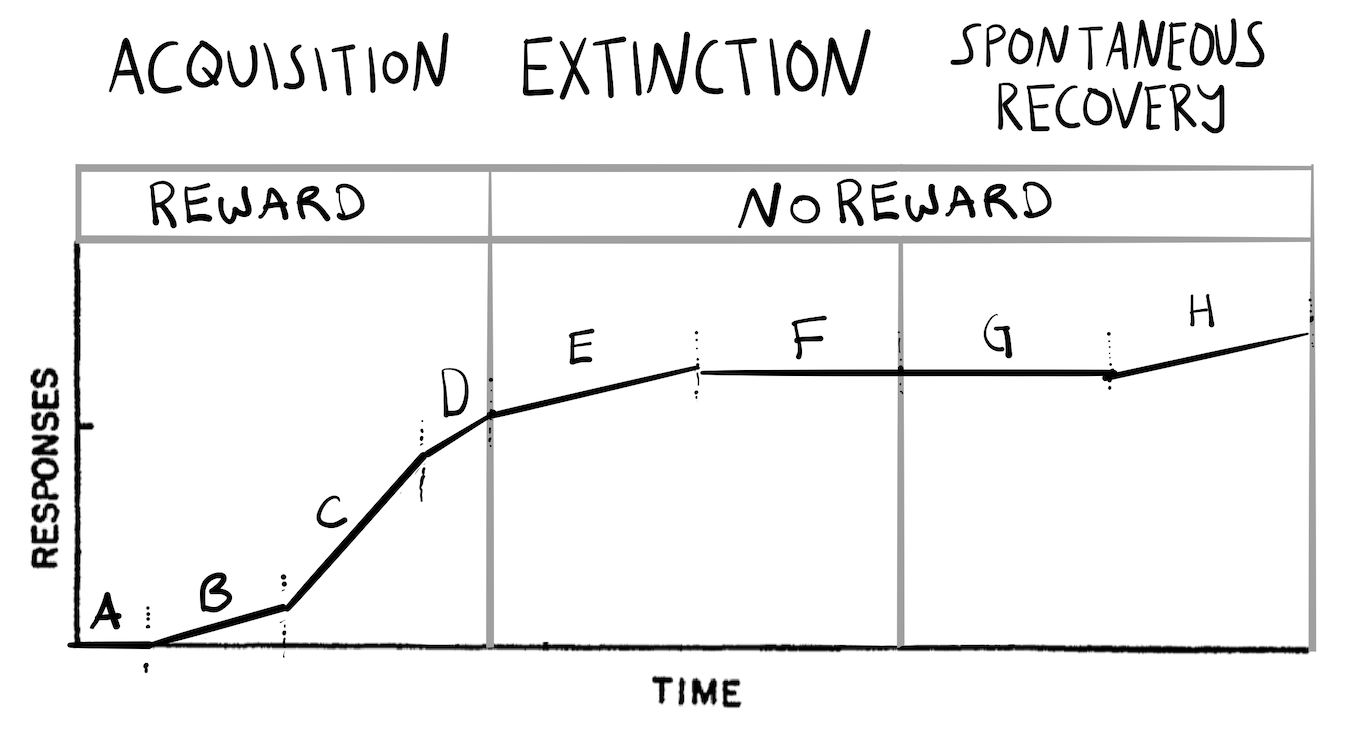
To get a better feel for Skinner’s system, the next section uses everyday language to describe this graph, and the following sections use Skinner’s system to describe the graph.
6.7.2.1 Everyday Description
In the acquisition phase, the animal is rewarded with food every time the lever is pressed. Initially, the animal doesn’t respond (A); then, it responds at a low rate and learns it will receive a reward (B). After the “insight” that responding gives a reward the animal starts pressing the button at a high rate (C). As the animal gets many rewards, it becomes less hungry, the reward is less desirable, and the rate of responding starts to decrease again (D).
During the extinction phase, the lever-pressing behavior no longer triggers any food reward. The animal continues to press the lever, perhaps because it expects to get the food reward (E), but over time, the animal learns that pressing the lever does not bring food, so it slows or even completely stops responding (F).
Finally, the animal is left in the box even though it has stopped responding. Just like in Pavlovian conditioning, it is possible to observe spontaneous recovery. For example, the animal may not press the lever for a while (G), but after some time, it will often start pressing the lever again (H), as if it expects food, even though it is no longer getting any.
6.7.2.2 Systematic Description: Setting terms and laws
Skinner’s system involved his own set of terms and law relationships. The terms were intended as abstractions, and the laws were supposed to be empirically verified regularities in behavior. The system could be modified over time if new experiments revealed new laws or forced revisions of old laws. Also, terms in the system could be added or subtracted depending on whether they were useful for describing behavior.
Skinner used terms like reflex and reflex strength, but stripped them of their normal everyday meaning. For example, his reflex just refers to any operant behavior, like lever-pressing, and is not to be mistaken with a real reflex, like the patellar knee jerk.
Similarly, reflex strength was an abstract quantity in the system, referring to changes in behavior over time, and not the magnitude or intensity of a response. Reflex strength increased as the response rate increased, and did not refer to how strongly or weakly the animal made a particuar response.
Other terms involved concepts like threshold, latency, after-discharge, which were defined by postulated laws of behavior, such as:
The Law of Threshold The intensity of the stimulus must reach or exceed a certain critical value (called the threshold) in order to elicit a response.
The Law of Latency An interval of time (called the latency) elapses between the beginning of the stimulus and the beginning of the response.
The Law of the Magnitude of the Response The magnitude of the response is a function of the intensity of the stimulus.
The Law of After-Discharge The response may persist for some time after the cessation of the stimulus
The prospect of proposing scientific laws for behavior was a hopeful long shot. Behaviorists were modeling themselves after other disciplines like physics, where many physical laws had been discovered. However, the behavior of animals can be highly complex and not easily captured by simple laws. To accommodate the complexity, Skinner postulated laws in a vague and provisional way. For example, in the law of after-discharge, the response may persist for some time, but it may not. He also postulated dynamic laws that allow parts of the system to change. Here is an example:
The Law of Reflex Fatigue. The strength of a reflex declines during repeated elicitation and returns to its former value during subsequent inactivity.
By invoking this law, Skinner allows other static properties of the system to change. He writes, “if a reflex is repeatedly elicited at a certain rate, its threshold is raised, its latency is increased, and the R/S ratio [ratio between the magnitude of the response and magnitude of the stimulus] and the after-discharge is decreased.”
Finally, Skinner sometimes proposed additional hypothetical constructs like a reflex reserve.
“I shall speak of the total available activity as the reflex reserve, a concept that will take an important place m the following chapters. In one sense the reserve is a hypothetical entity. It is a convenient way of representing the particular relation that obtains between the activity of a reflex and its subsequent strength. But I shall later show in detail that a reserve is clearly exhibited in all its relevant properties during the process that exhausts it and that the momentary strength is proportional to the reserve and therefore an avail- able direct measure The reserve is consequently very near to being directly treated experimentally, although no local or physiological properties are assigned to it.”
6.7.2.3 Example Skinnerian Description
Let’s reconsider the trends in rat lever-pressing behavior shown in Figure 21, but use Skinner’s system to describe the behavior.
The rat has an initial reflex reserve giving it some propensity to make the reflex. Prior to acquisition, some unknown impulse causes a threshold to be reached, and the reflex is spontaneously emitted. The impulse doesn’t occur often, or the threshold is very high, so the reflex strength is low overall because it occurs infrequently.
During the acquisition phase, the animal is inserted into the box. During phase A, the reflex threshold is not exceeded, and no reflexes are emitted. During phase B, some impulses spontaneously pass the reflex threshold, and the reflex is emitted at a low rate. Now, we must invoke another law:
“The Law of Conditioning of Type R. If the occurrence of an operant is followed by presentation of a reinforcing stimulus the strength is increased.”
During phase B, the reflex strength increases as it is reinforced. This is observed in behavior through an increase in response rate. During phase C, the reflex strength, and possibly the reflex reserve, grows substantially. This is shown by an increase in response rate. However, during phase D, the response rate starts to decline. This could indicate a change in some part of the system, such as a raised threshold that requires a greater impulse to trigger the reflex. Alternatively, the hypothetical reflex reserve might be coming into play. The reserve could be depleting, which can be observed in behavior as a decrease in response rate.
During the extinction phase, reflex continues to occur even though it is not reinforced in phase E. The continuation of the reflex could be due to after-discharge. However, an additional law can be stated to describe the reduction of the rate of responding:
The Law of Extinction of Type R. If the occurrence of an operant already strengthened through conditioning is not followed by the reinforcing stimulus, the strength is decreased.
During phases E and F, the extinction law postulates how reflex strength is decreased. This is observed in behavior as a rate reduction. Finally, spontaneous recovery in phase H can be described by incomplete extinction.
6.7.3 Applications of operant conditioning
Skinner’s operant conditioning research was oriented toward application. The purpose of exhaustively describing the properties and relations of a simple behavior like lever-pressing was to achieve a generalizable system useful for controlling and manipulating other behaviors. Skinner used his methods successfully for applications like training animals (Skinner, 1951).
One interesting example is Skinner’s project pigeon, conducted during World War II. Guided missile technology had not been perfected, and missiles were missing their targets. Skinner had the idea to place pigeons inside of missiles and train them to guide the missiles toward their targets. Pigeons are very good at pecking, and through operant conditioning, they could be trained to repeatedly peck on a visual target. In this way, a missile could be guided toward a target using the pecking from a pigeon as a steering wheel for the missile. More broadly, operant conditioning techniques are very commonly used in modern animal training (Pryor & Ramirez, 2014).
The field of applied behavior analysis also uses operant conditioning techniques on people. For example, positive and negative reinforcements are used to increase or decrease wanted or unwanted behaviors in humans.
6.7.4 Implications: Skinner’s Utopia
Skinner’s system of behaviorism was constructed in the tradition of positivism discussed throughout this chapter. Just like Watson and Tolman, Skinner extended his ideas outside the realm of science to the realm of society. His views on how his finding should be extended appeared to change over time.
In concluding his work on lever-pressing in 1938, Skinner wrote, “The book represents nothing more than an experimental analysis of a representative sample of behavior. Let him extrapolate who will”. He suggested that anyone who understood what he was saying could easily make the extrapolation themselves, but resisted spelling out any major speculations.
However, just like Watson had envisioned a society guided by his behaviorism, by 1948, Skinner tried his hand at Utopian science fiction and wrote Walden Two (Skinner, 1948). The story describes how behavioral engineering through elaborate operant conditioning could improve the lives of 1000 people in a commune by ensuring they would live happy, productive, and conflict-free lives. The commune also planned to use genetic engineering to eliminate undesirable offspring in the future and engaged in other eugenic practices like preventing marriage between people with low or incompatible IQs. In a 1976 preface to the book, Skinner reflects on his motivations for writing it and develops an argument that society will collapse unless it finds ways to modify itself, and that Walden Two could be a good example of a place to start.
6.8 Exit Behaviorism?
Depending on who is telling the history, behaviorism could be the dark ages of psychology that stood in the way of modern cognitive psychology, or a fore-bearer paving the way. Some aspects of behaviorism have been discarded and others have been retained in the modern cognitive sciences. ny have also be retained.
A commonality among the behaviorists we discussed was that they all followed positivism in rejecting theological and metaphysical “explanations” of natural phenomena. For example, they criticized introspectionist and mentalist psychology as being unscientific, or still in the religious or metaphysical stages. The rejection of mentalism was a denial of cognition, but perhaps only a pragmatic one–that is, it was useful to deny a role for cognition until it was needed in the system, and then it wouldn’t be denied anymore. Remember, the goal of the descriptive system was to predict and control behavior. If the system could be constructed without reference to “cognition”, then “cognition” was not necessary for the system to achieve its goal of prediction and control. This was not necessarily a denial that people had cognition.
As we move into the transition from behaviorism to cognitivism the wholesale denial of cognitive operations becomes less popular. However, aspects of positivist philosophy are not as readily discarded in cognitivism, such as the format of theorizing, and the rejection of theological and metaphysical considerations. At the same time, cognitivism comes of age in a period of post-positive thinking, which leads to a multiplicity of viewpoints. For example, it is possible to have multiple theories for the same phenomena, each with different strengths, limitations, internal working structure (or not), and general usefulness (e.g., for generating new research questions, or applications, or other insights). So, in the post-behaviorism years, we find a diversity of approaches to cognition.
The next chapter examines the concept of information processing and the introduction of “information theory” to psychology. This is a story about how ideas from computer science and communication technology would shape the questions we ask and answer about cognition.
–>
6.9 Appendix
6.9.1 References
Footnotes
that’s 41.6 million days worth of videos, or 114,155 years worth of video↩︎
e.g., the 1848 French revolution to remove the monarchy↩︎
Social discourse in Brazil was influenced by positivism and Ordem and Progresso remains the national motto↩︎
In this publication Ivan P. Pavlov was written as J. P. Pawlow.↩︎
according to Tolman↩︎
and others, Holt, de Laguna, Weiss↩︎
taken from wikipedia↩︎
Reuse
Citation
@incollection{crump2021,
author = {Crump, Matthew J. C.},
editor = {Crump, Matthew J. C.},
title = {Behaviorism},
booktitle = {Instances of Cognition: Questions, Methods, Findings,
Explanations, Applications, and Implications},
date = {2021-09-01},
url = {https://crumplab.com/cognition/textbook},
langid = {en},
abstract = {This chapter covers the school of behaviorism, which rose
to prominence in American psychology in the early 20th century.}
}
